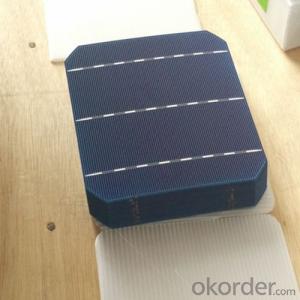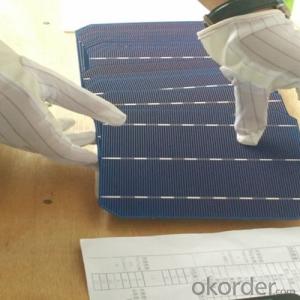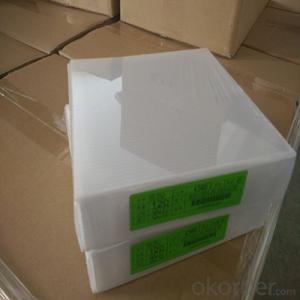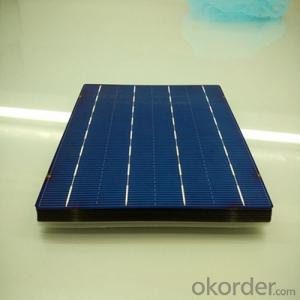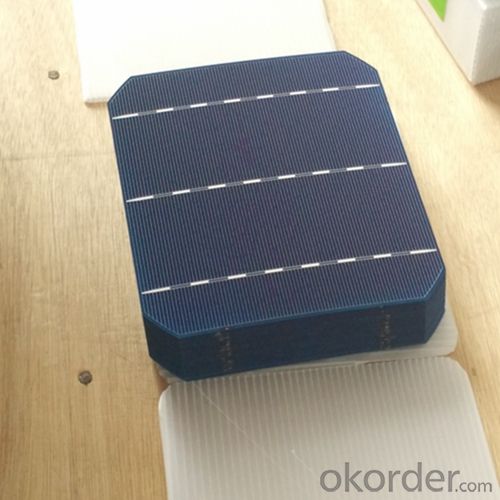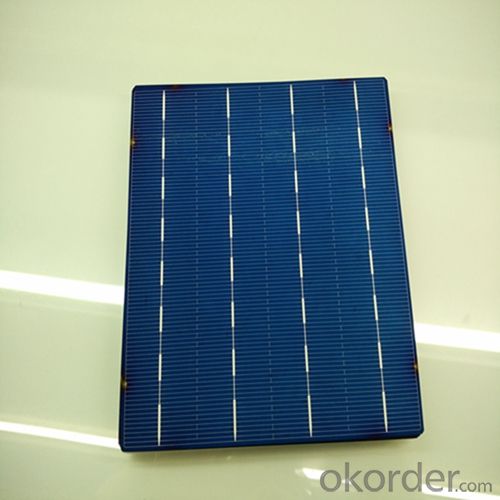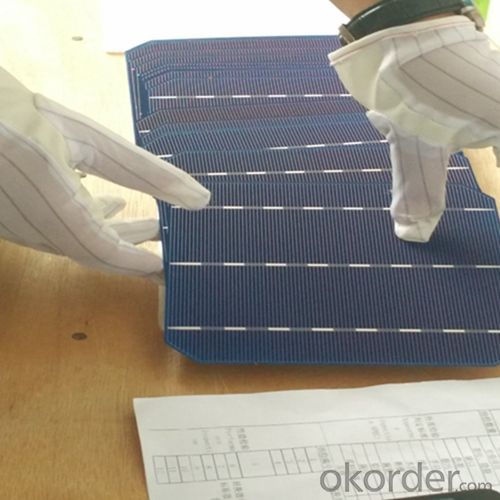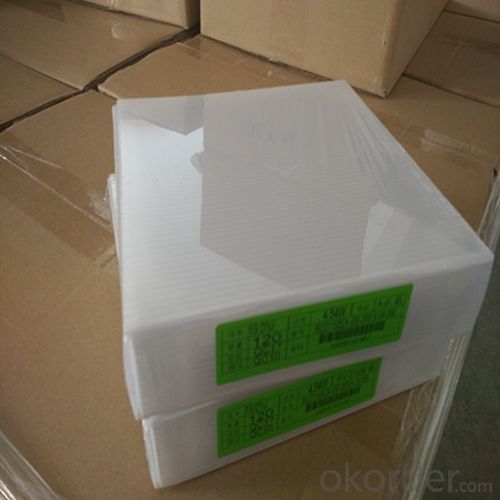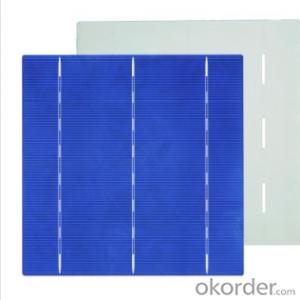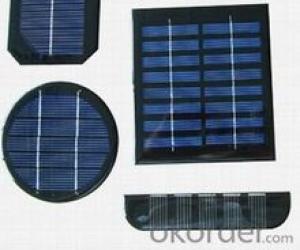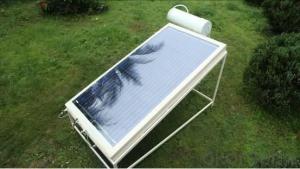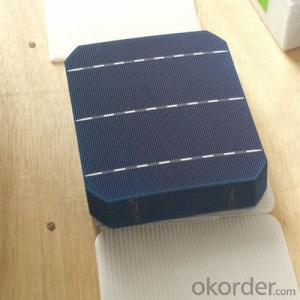Chinese Solar Cells - Poly 156x156mm2 Grade 1 Solar Cells
- Loading Port:
- Shanghai
- Payment Terms:
- TT OR LC
- Min Order Qty:
- 6000 watt
- Supply Capability:
- 6000000 watt/month
OKorder Service Pledge
OKorder Financial Service
You Might Also Like
The operation of a photovoltaic (PV) cell requires 3 basic attributes:
The absorption of light, generating either electron-hole pairs or excitons.
The separation of charge carriers of opposite types.
The separate extraction of those carriers to an external circuit.
In contrast, a solar thermal collector supplies heat by absorbing sunlight, for the purpose of either direct heating or indirect electrical power generation from heat. A "photoelectrolytic cell" (photoelectrochemical cell), on the other hand, refers either to a type of photovoltaic cell (like that developed by Edmond Becquerel and modern dye-sensitized solar cells), or to a device that splits water directly into hydrogen and oxygen using only solar illumination.Characteristic of Mono 156X156MM2 Solar Cells
You are gaining energy independence - add battery backup power for even greater energy security
The cost of electricity is only going to rise – insure against that rising cost
Adaptive cells change their absorption/reflection characteristics depending to respond to environmental conditions. An adaptive material responds to the intensity and angle of incident light. At the part of the cell where the light is most intense, the cell surface changes from reflective to adaptive, allowing the light to penetrate the cell. The other parts of the cell remain reflective increasing the retention of the absorbed light within the cell.[67]
In 2014 a system that combined an adaptive surface with a glass substrate that redirect the absorbed to a light absorber on the edges of the sheet. The system also included an array of fixed lenses/mirrors to concentrate light onto the adaptive surface. As the day continues, the concentrated light moves along the surface of the cell. That surface switches from reflective to adaptive when the light is most concentrated and back to reflective after the light moves along
Mechanical data and design
Format | 156mm x 156mm±0.5mm |
Thickness | 210μm±40μm |
Front(-) | 1.5mm bus bar (silver),blue anti-reflection coating (silicon nitride) |
Back (+) | 2.5mm wide soldering pads (sliver) back surface field (aluminium) |
Temperature Coefficient of Cells
Voc. Temp.coef.%/K | -0.35% |
Isc. Temp.coef .%/K | +0.024%/K |
Pm.Temp.coef. %/K | -0.47%/K |
Electrical Characteristic
Effiency(%) | Pmpp(W) | Umpp(V) | Impp(A) | Uoc(V) | Isc(A) | FF(%) |
18.35 | 4.384 | 0.526 | 8.333 | 0.63 | 8.877 | 78.39% |
18.20 | 4.349 | 0.526 | 8.263 | 0.63 | 8.789 | 78.54% |
18.05 | 4.313 | 0.525 | 8.216 | 0.63 | 8.741 | 78.32% |
17.90 | 4.277 | 0.524 | 8.161 | 0.625 | 8.713 | 78.04% |
17.75 | 4.241 | 0.523 | 8.116 | 0.625 | 8.678 | 77.70% |
17.60 | 4.206 | 0.521 | 8.073 | 0.625 | 8.657 | 77.36% |
17.45 | 4.170 | 0.519 | 8.039 | 0.625 | 8.633 | 76.92% |
17.30 | 4.134 | 0.517 | 8.004 | 0.625 | 8.622 | 76.59% |
17.15 | 4.096 | 0.516 | 7.938 | 0.625 | 8.537 | 76.80% |
17.00 | 4.062 | 0.512 | 7.933 | 0.625 | 8.531 | 76.18% |
16.75 | 4.002 | 0.511 | 7.828 | 0.625 | 8.499 | 75.34% |
16.50 | 3.940 | 0.510 | 7.731 | 0.625 | 8.484 | 74.36% |
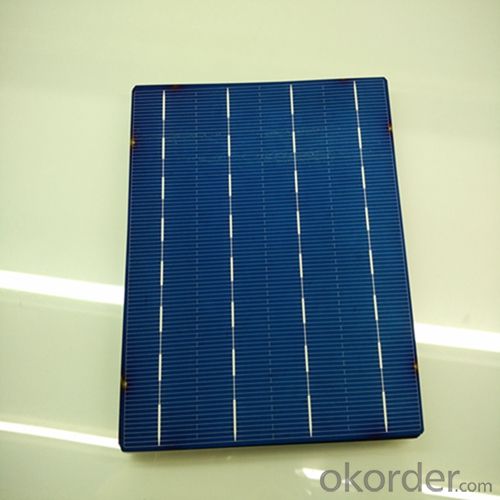
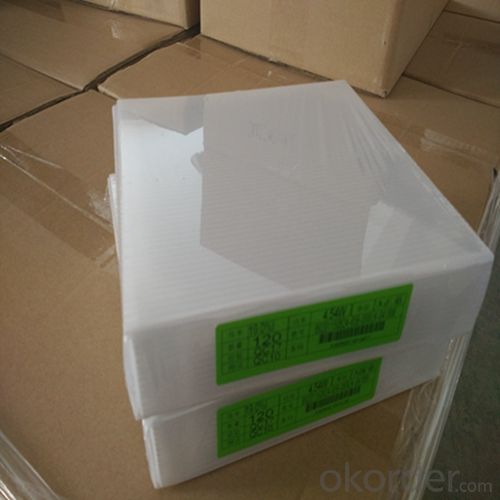
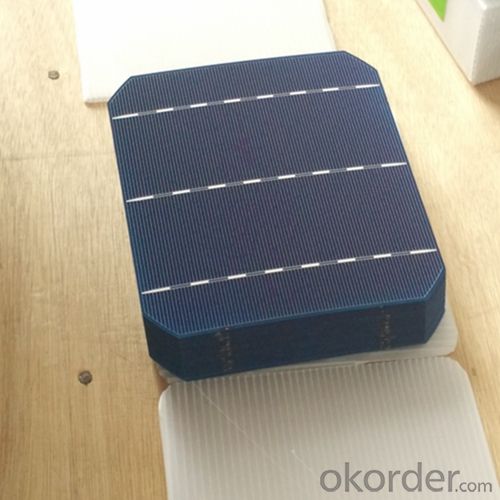
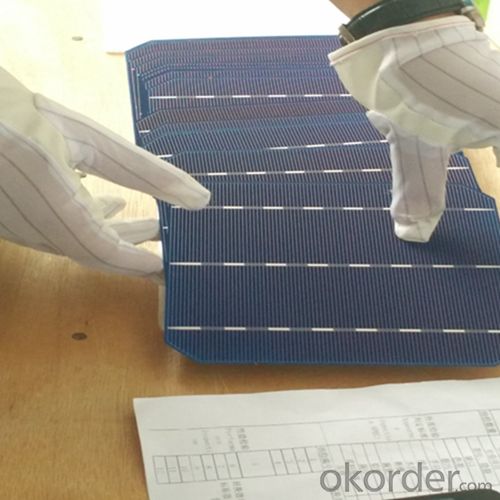
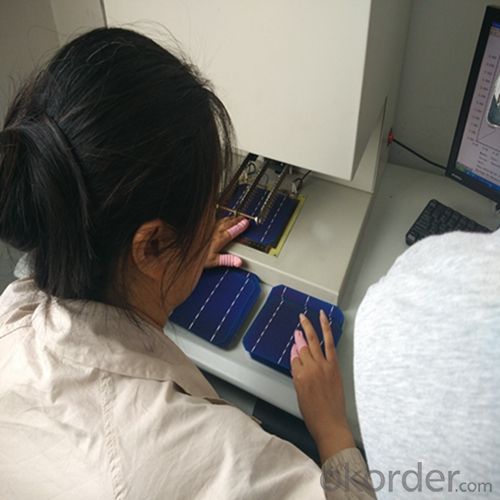 FAQ
FAQ
Q: What price for each watt?
A: It depends on the quantity, delivery date and payment terms, generally Large Quantity and Low Price
Q: What is your size for each module? Can you tell me the Parameter of your module?
A: We have different series of panels in different output, both c-Si and a-Si. Please take the specification sheet for your reference.
Q: What is your size for each module? Can you tell me the Parameter of your module?
A: We have different series of panels in different output, both c-Si and a-Si. Please take the specification sheet for your reference.
- Q: What are the maintenance requirements for solar cells?
- The maintenance requirements for solar cells are minimal. They generally require regular cleaning to remove dust or debris that may accumulate on the surface, and occasional inspection to ensure proper functioning and detect any signs of damage or wear. Additionally, it is recommended to check the connections and wiring periodically to ensure they are secure. Overall, solar cells are known for their durability and low maintenance needs.
- Q: How do solar cells perform in areas with high levels of electromagnetic interference?
- Solar cells may be affected by high levels of electromagnetic interference (EMI) in areas where strong electromagnetic fields or radio frequency signals are present. EMI can disrupt the normal functioning of solar cells, leading to reduced efficiency or even complete failure in extreme cases. To overcome this issue, it is important to employ proper shielding and grounding techniques to minimize the impact of EMI on solar cells. Additionally, advanced designs and technologies are constantly being developed to enhance the EMI tolerance of solar cells, ensuring their optimal performance even in areas with high levels of electromagnetic interference.
- Q: Can solar cells be used to power communication systems?
- Yes, solar cells can be used to power communication systems. Solar cells are capable of converting sunlight into electricity, which can then be used to power various electronic devices, including communication systems. This is particularly advantageous in remote or off-grid areas where it may be difficult or expensive to establish traditional power infrastructure. Additionally, solar-powered communication systems offer a sustainable and environmentally friendly alternative to relying solely on fossil fuels for energy.
- Q: How do solar cells affect the electricity grid?
- Solar cells affect the electricity grid by injecting clean and renewable energy into the system. When solar cells generate excess electricity, it can be fed back into the grid, reducing the demand for electricity from traditional power plants. This helps diversify the energy sources and reduce carbon emissions. However, the intermittent nature of solar power can pose challenges to grid stability and require additional infrastructure investments for efficient integration.
- Q: Can solar cells be used to power parking meters?
- Yes, solar cells can be used to power parking meters. They can efficiently convert sunlight into electricity, providing a sustainable and reliable source of power for parking meters without the need for continuous grid connection or batteries.
- Q: What is the impact of solar cells on reducing electricity bills?
- Solar cells have a significant impact on reducing electricity bills as they generate renewable energy from the sun, which can be used to power homes or businesses. By harnessing solar power, individuals can reduce their reliance on traditional electricity sources, resulting in lower monthly bills. Additionally, excess energy produced by solar cells can be fed back into the grid, earning credits or payments that further offset electricity costs. Overall, solar cells provide a sustainable and cost-effective solution for reducing electricity bills.
- Q: What is the average lifespan of a solar cell in space?
- The average lifespan of a solar cell in space can vary depending on several factors, such as the quality of the materials used, exposure to radiation, and maintenance. Generally, solar cells in space are designed to last anywhere from 10 to 25 years, but some have been known to continue functioning well beyond that timeframe.
- Q: Can solar cells be used for powering remote surveillance cameras?
- Yes, solar cells can be used to power remote surveillance cameras. Solar cells convert sunlight into electricity, making them a reliable and sustainable energy source for remote locations where power supply may be limited or unavailable. By harnessing solar energy, surveillance cameras can operate continuously without the need for frequent battery replacements or connection to electrical grids.
- Q: What materials are used in solar cells?
- The most common materials used in solar cells are silicon, which is the dominant material in the market, as well as other materials such as cadmium telluride, copper indium gallium selenide, and organic materials like polymers.
- Q: Can solar cells be used in remote areas without access to the grid?
- Yes, solar cells can be used in remote areas without access to the grid. Solar cells, also known as photovoltaic cells, generate electricity from sunlight. They can be installed in remote areas to harness the sun's energy and provide power for various applications such as lighting, water pumping, and charging electronic devices. Solar cells are particularly suitable for off-grid locations as they operate independently of the traditional electric grid, making them a reliable and sustainable solution for remote areas.
Send your message to us
Chinese Solar Cells - Poly 156x156mm2 Grade 1 Solar Cells
- Loading Port:
- Shanghai
- Payment Terms:
- TT OR LC
- Min Order Qty:
- 6000 watt
- Supply Capability:
- 6000000 watt/month
OKorder Service Pledge
OKorder Financial Service
Similar products
Hot products
Hot Searches
Related keywords
